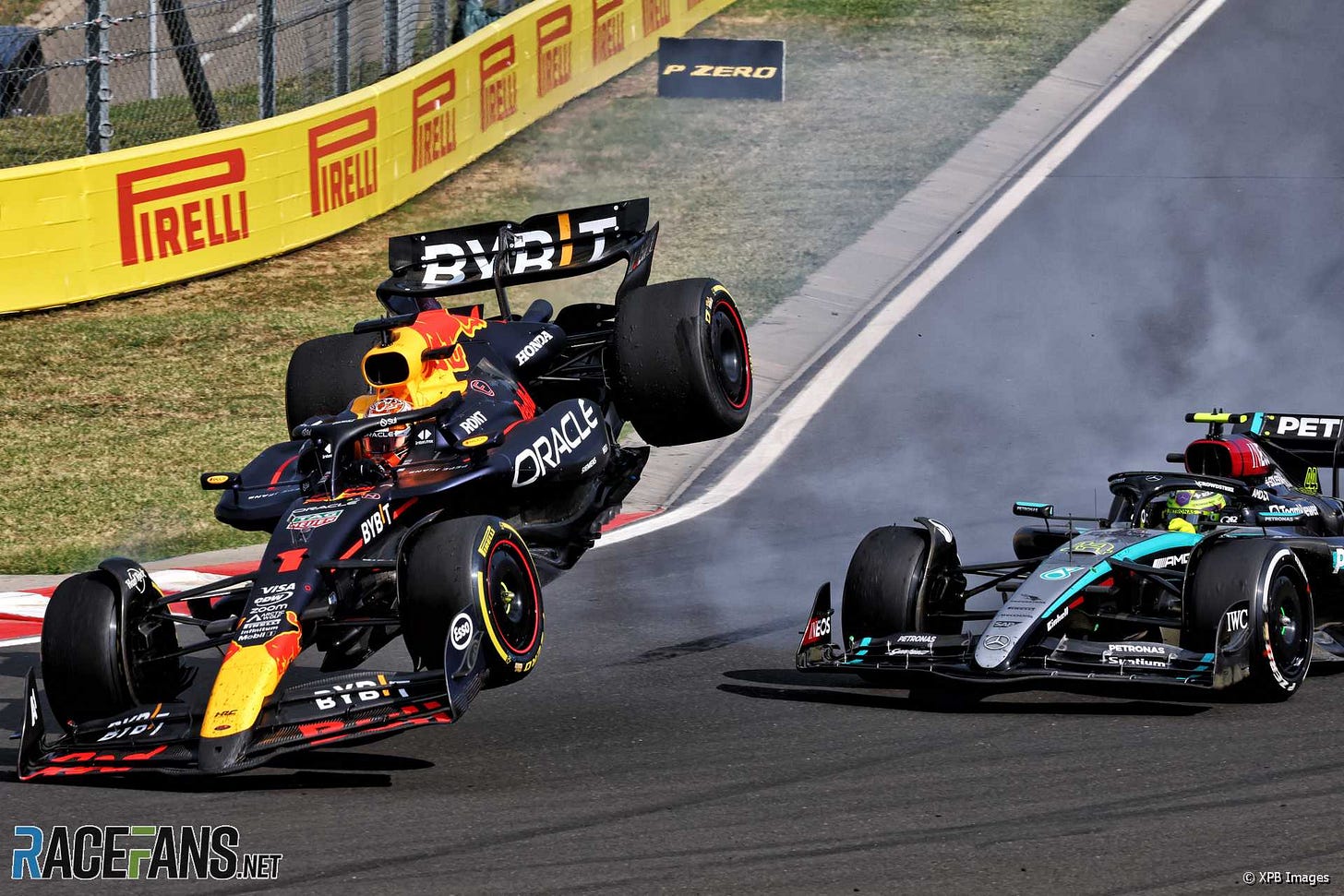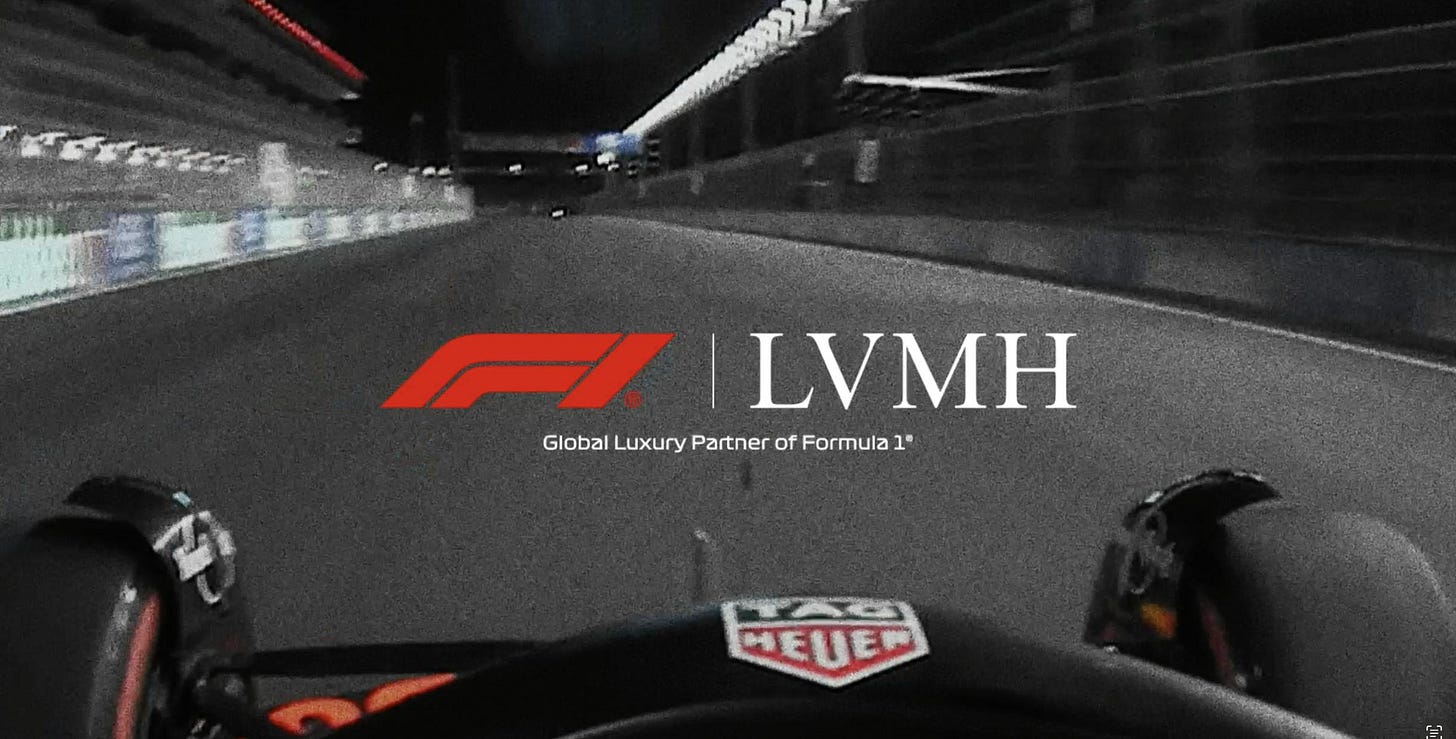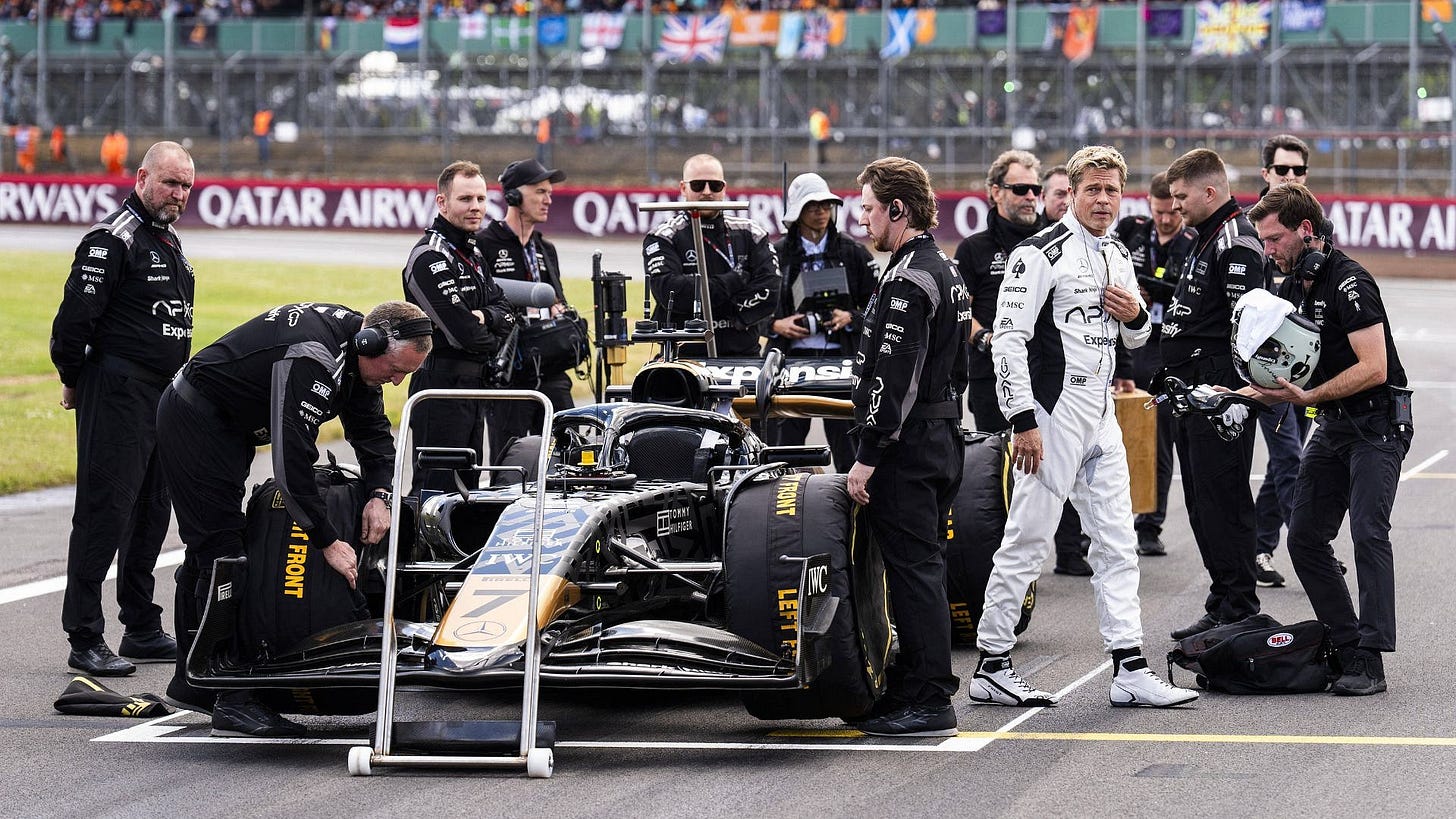Ideas We Love: F1. The Movie 🏁
Issue Number 59: A look inside Liberty Media's transformation of F1 and their biggest bet yet
Hi there. How are you?
Very hot in the U.K. this week again. Not in a good way. Lack of sleep and bright mornings make for grumpy writers.
However one way people can escape the heat for a couple of hours is to sit in a lovely, dark, air-conditioned cinema and enjoy the latest movie.
Which acts as a deliberate segue to the topic of this week’s newsletter which is the latest release from Apple TV’s movie slate in F1: The Movie.
Before we get into that though, a hat-tip to Liberty Media’s ongoing transformation of the sport itself. Under Liberty Media’s leadership, It’s a great example of what we like to call “layered” thinking in practice that we spotlighted last week.
At the core of Formula 1 sits its core Product: the racing spectacle itself.
A world of fast cars, cutting-edge technology, elite drivers and teams locked in fierce competition; where fractions of seconds separate winning and losing. The product at its best is raw, visceral and deeply differentiated from any other sport which acts as the stage for everything else F1 does.
Wrapped around that sits an evolving Brand layer.
Under Liberty Media, F1 has evolved from feeling exclusive and elitist to something more modern, dynamic, and x-culturally relevant; leveraging their iconic teams, drivers and races to create a delicious cocktail of glamour and drama.
The strength of the F1 brand and product sets-up an increasingly dynamic Commerce layer; which consistently finds new ways to monetise the growing passion and enduring prestige of the circuit.
Beyond race tickets, there’s a booming market for premium race-weekend experiences such as the F1 Paddock Club, that’s extended through licensing deals and partnerships with brands from Lego to LVMH that keep the sport present in fans’ daily lives and create new revenue streams too.
Revenue streams that are going up and to the right as you’ll see below.
Most famously in our world of marketing, F1 has also become a Content powerhouse beyond raceday too; which given many of the last few race seasons themselves have been processions by Max Verstappen to the title, ramps up the drama, excitement and anticipation around the sport even when it might be lacking on the track.
Drive to Survive’s soap opera on the pit lane has created a swathe of ‘celebrity’ drivers hasn’t just re-engaged their core fan-base, but critically has helped recruit the next-generation of fans and break America too; creating new fans that can follow the drivers, teams and the sport itself across social media that deepens their connection to the sport and desire to watch at home or track-side.
Finally, there’s Context which in F1 isn’t just about data or DCO; it’s about weaving the circus at each stop into the cultural context of the cities and countries they’re racing in.
As F1 travels the world, it adapts and morphs to the subcultures, communities, celebrities and just the general vibes of each location on tour. Whether it’s embracing the neon glitz of Las Vegas, the historic glamour of Monaco, or the growing buzz in places like Miami; F1 tailors its presence, partnerships and storytelling to be of that location in ways that resonate everywhere people are looking on.
All of this is emblematic of how F1 is no longer just a sport for petrolheads, with a sprinkling of glitterati, but is now very much a layered entertainment ecosystem; with pull across all sorts of sub-cultures and communities that can elegantly plug big brands and big budgets into those layers to extract some of that lovely cultural and commercial juice of the spectacle in mutually beneficial ways.
So why Hollywood? Why now?
As impressive as Liberty’s transformation of the sport has been, looking at the admittedly singlular data-point of interest in and around the topic of F1, suggests some additional firepower might be required to breakthrough the recent plateau of interest in and around the sport following the success of Drive to Survive; another idea we loved coming out of F1 from Issue #5.
And no single project is symbolic of just how well F1 can serve itself, by serving others, than the upcoming F1 movie with beautiful Brad Pitt.
At first glance, it’s easy to see the movie as simply an expansion of its Content layer; a promotional, glitzy, shot in the arm. However to make something even more dramatic and even more glamorous than the circus itself doesn’t just require Hollywood money; it needs Silicon Valley money.
Welcome Apple; sitting on the biggest cash-pile in corporate history.
Happy to underwrite the cost of the production, retain streaming rights for AppleTV+ and bring along Warner Bros to help with theatrical distribution. No doubt securing some right of first refusal should F1 decide to pool all their live broadcast rights into one streaming platform; but that’s a whole other story.
Apple and Formula 1 have spent two years and hundreds of millions of dollars creating one of the most ambitious sports films ever made; with beautiful Brad starring as a retired driver returning to help a struggling F1 team alongside up-and-coming talent Damson Idris, directed by Joseph Kosinski of Top Gun: Maverick and produced by none other than Jerry Bruckheimer.
Strong.
An A-Team that no doubt was primed for even more success via the ways they could deliberately weave the production into the real world spectacle of F1.
At the heart of the project is how it integrates into F1s core Product, real-world racing. It would likely have been cheaper to green-screen the action, but instead of relying on special effects, director Joseph Kosinski and his team shot footage during actual Grand Prix weekends, capturing the raw energy of real races across the past two seasons.
They didn’t just integrate with the races, they partnered with the teams too.
Working with Mercedes to build custom race cars that passed official FIA safety tests, while 6K cameras were mounted inside cockpits, offering audiences a view of the sport’s speed and precision like never before.
This authenticity ensures the film reflects F1’s true spirit and technological edge and no doubt, a bit like RedBull’s various capes, creates new camera tech that can benefit F1s core product at the same time.
The Discoverability layer has been equally critical for building hype for the movie.
For two years, Brad Pitt has been visible in the F1 paddock, walking up and down the grid, looking and no doubt smelling amazing, mingling with drivers, and becoming part of race weekend buzz whilst shooting.
These appearances haven’t just been about filming though, they’ve served as organic promotion, generating curiosity and coverage that’s made both the film and F1 with it more discoverable to wider audiences who might never have even watched a race before. More on that shortly.
Commerce plays a big role too. The fictional team featured in the movie secured real-world sponsorships, reportedly generating over $40 million in brand partnerships before the film even premiered. Not to mention a whole bunch of associated merch that will be flying off the shelves, because “I’ll have what Brad wore”.
Alas finally, the Content layer has transformed this film into far more than a single piece of entertainment relevant at a single moment in time.
With a reported $240 million budget, it’s one of the most expensive films ever produced, backed by a unique release plan that pairs a global theatrical launch through Warner Bros. with eventual streaming on Apple TV+. Beyond the movie itself, there’s been a steady flow of social media content, behind-the-scenes footage, and coverage of Pitt’s presence at live races both on-air and online.
All of which fuelling ongoing earned media, keeping fans engaged and building anticipation well ahead of the film’s release.
So is it working? For Apple and/or F1?
So far, the signs look promising.
Early reviews have been strong, with an initial 88% rating on Rotten Tomatoes that’s holding at 83% now; with box office estimates suggest they doubled the predicted opening weekend gross of $60-75 million.
More importantly for F1, the movie seems to be working as a growth engine for the sport itself.
In U.S. test screenings, only 18% of audiences had even heard of Formula 1 beforehand, which seems pretty wild to a European, but over 80% said they’d definitely recommend the film; a level of enthusiasm producer Jerry Bruckheimer calls unprecedented. And, as Apple’s Eddy Cue put it, hardly anyone in early audiences had seen a race going in, but by the end, nearly everyone wanted to go to one.
The clearest sign yet that the film isn’t just a vanity exercise, but it’s courting and converting new fans for the sport; with projects like this movie acting as powerful new revenue accelerators for parent company Liberty Media.
Matt’s excited to take his boys to watch it at the weekend. Hoping it’s not a let down ; )
As always, thanks for reading!
Until next time, Cheerio
Tom & Matt x














